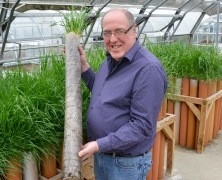Holding back the flood

Dr Mike Humphreys and the Festulolium hybrid
30 April 2013
A new grass species’ hybrid developed by researchers at Aberystwyth University could help reduce the impact of flooding.
Recent research published by a collaboration of plant scientists from across the UK, show that a new grass hybrid developed by plant breeders at the Institute of Biological, Environmental and Biological Research (IBERS) at Aberystwyth University has the potential to alleviate flooding.
The hybrid can capture more water in soils than is possible with current agricultural grasses. This then reduces runoff which could help minimise flood generation.
The BBSRC-funded scientists, from IBERS, Rothamsted Research, the James Hutton Institute, Lancaster University and the University of Nottingham, studied a Festulolium variety, a grass hybrid derived from perennial ryegrass (Lolium perenne) and meadow fescue (Festuca pratensis).
They hoped to show that integrating the rapid establishment and growth rate of the ryegrass with the large, well developed root systems of the meadow fescue would improve soil structure that could reduce flooding.
Over two years of field experiments in Devon the team demonstrated that the Festulolium hybrid reduced water runoff from agricultural grassland by up to 51 per cent compared to a leading UK nationally-recommended perennial ryegrass variety and by 43 per cent compared to meadow fescue, its two parental species.
It is thought the reduced runoff is achieved because Festulolium’s intense initial root growth and subsequent rapid turn-over, especially at depth, generates a more porous soil which allows more water capture.
The hybrid grass also provides high quality forage with resilience to weather extremes, making the grass doubly useful to farmers.
Dr. Mike Humphreys principal researcher at IBERS and one of the authors of the paper, said, “Festulolium, which are defined as natural hybrids between ryegrass and fescue species, are very much the grasses for the future. They are the way ahead for sustainable livestock agricultural practices.
“They bring increased resilience to climate change and more water and nutrient-use efficiency together with several examples of environmental service. This is mainly due mainly to their large well developed root systems.
“Their root systems combat flooding, reduce soil erosion and compaction and offer opportunities for significant Carbon sequestration.”
Grasslands occupy 76 per cent of agricultural land in the UK and are most prevalent in the west and north – also the areas of greatest rainfall and catchment areas for many of our rivers. More detailed and longer studies are required to fully determine the full potential of Festulolium for flood control but the signs are very promising.
If the results at a larger scale reproduce outcomes found in the pilot studies then a very cost effective technology becomes available for flood control.



